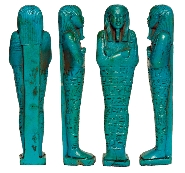

|
|
|||||||||||||||||||||
|
2181 BC
|
2040
|
1782
|
1570
|
1070
|
525
|
332
|
30 BC
|
|
|||||||||||||
|
|
|||||||||||||||||||||
|
|
|
||||||||||||||||||||
|
|
|||||||||||||||||||||
|
|
|||||||||||||||||||||
|
Late Period
By the Late Period (525-332 BC) the funerary statuettes became known as ushebtis which translates as ‘answerers.’ They were mostly made of light green or blue faience and were often very
carefully modelled
(1) (2). A feature common in ushebtis of this time is the dorsal pillar and trapezoidal base which, according to
Aubert, were inspired by these elements appearing in statuary of the period.
Coffins adopted similar iconography.
The ushebtis were made in two-piece pottery moulds with the inscription being incised with a
finely pointed tool prior to firing. Once again these figures are inscribed
with various versions of Chapter 6 of the Book of the Dead. 401 continued to
represent the prerequisite number of
ushebtis during the Late Period.
Although the earlier type of ‘overseer’ figure with the kilt of every day life rarely occurs beyond the Third
Intermediate Period it has been suggested that the two types are differentiated
during the Late Period by their inscriptions.
The figures were presumably carried to the tombs in large wooden boxes but these
are no longer to be regarded as
shabti boxes as they bear no inscription or decoration like those of earlier times. The
ushebtis were sometimes left in these boxes but more commonly they were stood in rows
around the burial chamber of the deceased or placed in niches in the walls of
the chamber.
|
|
||||||||||||||||||||
|
|
|||||||||||||||||||||
|
1. Faience ushebti for Psamtek
Late Period, 26th Dynasty
c. 570-526 BC
|
|
||||||||||||||||||||
|
|
|||||||||||||||||||||
|
|
|||||||||||||||||||||
|
|
|||||||||||||||||||||
|
2. Faience ushebti for the 'Chief of the Troops,' Pa-khaas, born to Ta-shedid
Late Period, 30th Dynasty
c. 380-343 BC
ex Horace Owen collection, London
|
|
||||||||||||||||||||
|
|
|||||||||||||||||||||
|
|
|
|
|
|
|
|
|
|
|
|
|
|
|
|
|
|
|
|
|
|
|





























